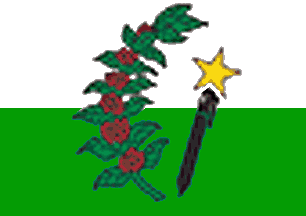
This page is part of © FOTW Flags Of The World website
P.A.J.O.C.A. (Angola)
Last modified: 2013-04-26 by bruce berry
Keywords: angola | pajoc |
Links: FOTW homepage |
search |
disclaimer and copyright |
write us |
mirrors
![[P.A.J.O.C.A. flag]](../images/a/ao}pajoc.gif) image
by Jorge Candeias, 28 Nov 2001
See also:
image
by Jorge Candeias, 28 Nov 2001
See also:
Partido da Aliança da Juventude Operária-Camponesa
de Angola (P.A.J.O.C.A.)
Partido da Aliança da Juventude Operária-Camponesa
de Angola (Party of the Working and Peasant Youth Alliance of Angola) has a flag
which is a horizontal bicolour of white over a sort of
dark greenish grey. It is charged with a branch of some plant (maybe our
resident botanists can identify what plant it is?), a yellow star drawn
as hand-drawing, and something brown that looks a bit like a whip or something
of the sort.
Jorge Candeias, 28 Nov 2001
The Partido da Aliança Juventude, Operários e Camponeses de Angola(PAJOCA)
was founded in 1991 and is now a small Angolan party. Following the 2008
Angolan parliamentary elections it failed to gain any of the 220 seats in
parliament, obtaining only 12 681 votes (0.24%). The Chr. Michelsen
Institute of Norway reports that:
The Partido de Aliança Juventude, Operáriaos e Camponeses de Angola
(Party of the Alliance of Youth, Workers and Farmers of Angola) was formed by a
group of soldiers that split away from the MPLA when
the country turned “turbo-capitalist”. The party still includes many of the army
rank and file. The party president (and outgoing deputy) is Alexandre Sebastião
André. The party sets itself apart from the MPLA not
only in terms of programmatic content, but in the ‘procedure’ of how politics
should be conducted.
 image by António MARTINS-Tuválkin, 04 Feb 2009
image by António MARTINS-Tuválkin, 04 Feb 2009
On the National Electoral
Committee
official website its flag the same as the one shown above but with several
variant details, such as the shade of green of the bottom stripe (much lighter)
and the exact rendering of the pictorial elements. This image allows us to
identify the device below the star as a fountain pen.
António MARTINS-Tuválkin, 04 Feb 2009
 image by António MARTINS-Tuválkin, 04 Feb 2009
image by António MARTINS-Tuválkin, 04 Feb 2009 
![[P.A.J.O.C.A. flag]](../images/a/ao}pajoc.gif) image
by Jorge Candeias, 28 Nov 2001
image
by Jorge Candeias, 28 Nov 2001